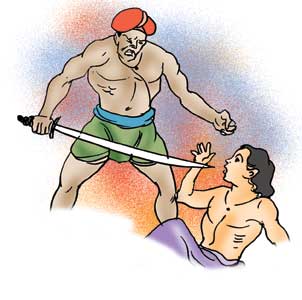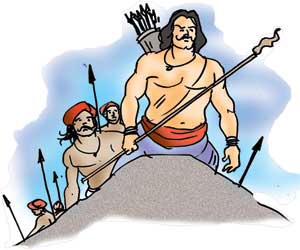
Development work undertaken~This article is part of a continuing series on the ‘Mahavamsa,’ the recorded chronicle of Sri Lankan history~
Both Veera-Pandya and Prince Kulasekera took Chola help and also fought against them, from time to time. An inscription written in 1186 AD, has been discovered. According to this inscription Vickrama-Pandya, has sought Chola assistance against Veera-Pandya. Then the Chola ruler had sent military assistance. These soldiers had killed the son of Veera-Pandya. The Sinhala soldiers who were on guard there, were punished by cutting off their noses. It is said that the Sinhala soldiers had then jumped into the sea.
The foreign policy of the Sinhala rulers of the time, did not differ much. All of them were harbouring a great hatred towards the Cholas. All the Pandya princes who fought against the Cholas, were supported by the Sinhala kings. But the Pandya princes were very opportunistic. They changed sides to suit their gain. However, the battles fought in South India, during the time of King Parakramabahu 1 were great and really heroic. He was able to suppress Chola power during his time. But we have to remember the fact that a lot of money was spent on these wars. Furthermore, King Parakramabahu had to spend a fortune to be the sole ruler of the entire country. It was possible for him to spend such a lot of wealth on these matters, as he had done enough of development work at the very beginning of his reign. He had developed agriculture to the highest possible standard.
Among all his irrigation works, the most important is the 'Parakrama Samudra,' which was built by amalgamating three tanks. The canals connecting them are also important. All these are connected to Ambanganga and the tributaries of the Mahaweli river. A dam was built across the Ambanganga, to collect the water. This water was directed to the Parakrama Samudra alo- ng the Angamadilla canal. He also found a way to increase the volume of water in the Ambanganga. For this purpose, he got a dam built across the Mahaweliganga. The water thus collected was directed to the Ambanganga, through Minipe canal. King Parakramabahu saw to it that the water of Parakrama Samudra was directed to far off places like Trincomalee. He had to get almost 11 canals cut, for this purpose. |
|
||||||
|| Front
Page | News | Editorial | Columns | Sports | Plus | Financial
Times | International | Mirror | TV
Times | Funday
Times || |
| |
Reproduction of articles permitted when used without any alterations to contents and the source. |
© Copyright
2008 | Wijeya
Newspapers Ltd.Colombo. Sri Lanka. All Rights Reserved. |
 There were disputes regarding the appointment of the Pandya ruler. That was due to the fact that the Cholas and the Sinhala people were on opposite camps. At one stage, the Cholas supported Kulasekera. But when he finally got friendly with the Sinhala people, the Cholas got angry and began to support Veera-Pandya. However, neither the Sinhala nor the Pandya kingdom had a true friendship with the Cholas. Though both parties sought Chola help, when they were in difficulty, the rulers were unable to win their confidence.
There were disputes regarding the appointment of the Pandya ruler. That was due to the fact that the Cholas and the Sinhala people were on opposite camps. At one stage, the Cholas supported Kulasekera. But when he finally got friendly with the Sinhala people, the Cholas got angry and began to support Veera-Pandya. However, neither the Sinhala nor the Pandya kingdom had a true friendship with the Cholas. Though both parties sought Chola help, when they were in difficulty, the rulers were unable to win their confidence. In this battle, Veera-Pandya had to retreat. The Cholas made Vickrama-Pandya the ruler of Madhura. According to this inscription, more soldiers had been sent from Sri Lanka, to help Veera-Pandya, during the time of King Parakramabahu. These armies had fought bravely and had captured certain provinces too. Thus, their defeat and retreat would have taken place, after the death of King Parakramabahu.
In this battle, Veera-Pandya had to retreat. The Cholas made Vickrama-Pandya the ruler of Madhura. According to this inscription, more soldiers had been sent from Sri Lanka, to help Veera-Pandya, during the time of King Parakramabahu. These armies had fought bravely and had captured certain provinces too. Thus, their defeat and retreat would have taken place, after the death of King Parakramabahu. King Parakramabahu is famous for his irrigation work. He had constructed about 65 dams and got a lot of canals cut. The ancient agricultural system was repaired by him. According to Chulavamsa, this king is supposed to have built 163 big tanks and 2376 small ones. This figure includes 3910 canals as well. He is supposed to have constructed 341 sluice-gates and about 1753 were repaired.
King Parakramabahu is famous for his irrigation work. He had constructed about 65 dams and got a lot of canals cut. The ancient agricultural system was repaired by him. According to Chulavamsa, this king is supposed to have built 163 big tanks and 2376 small ones. This figure includes 3910 canals as well. He is supposed to have constructed 341 sluice-gates and about 1753 were repaired.